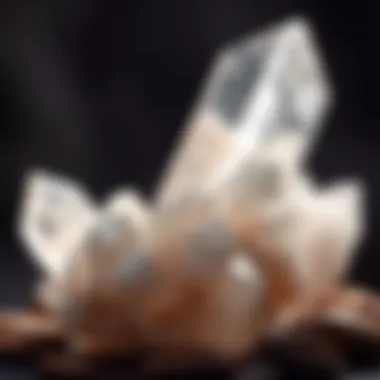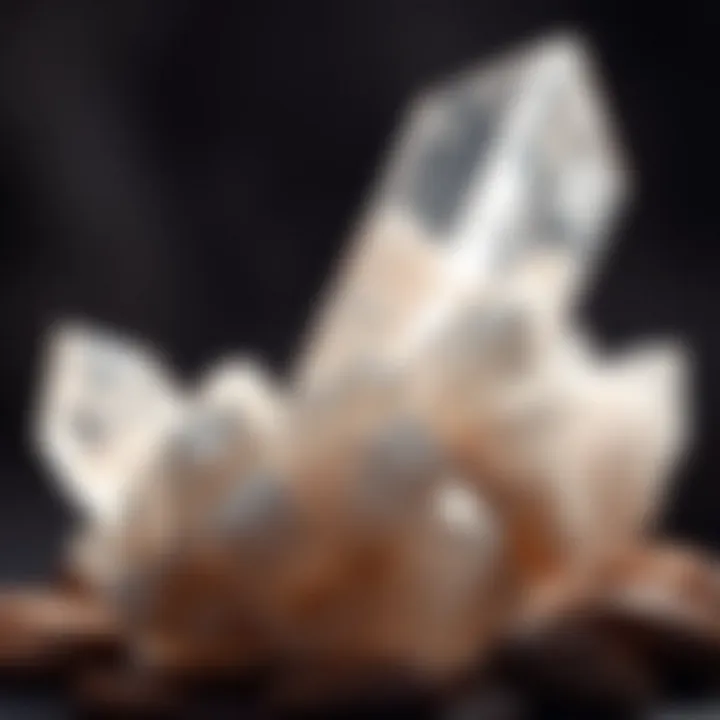Exploring Quartz in India: Its Roles and Varieties


Intro
The world of minerals holds treasures that go beyond mere geological formations. Among these, quartz stands out as a remarkable player, particularly in the context of India. This article takes a closer look at quartz—its significance, varieties, and applications—shining a spotlight on its multifaceted nature in Indian society.
As we delve deeper, we will dissect the geological formations that host various quartz deposits throughout the country. Understanding the historical context adds another layer; quartz has been woven into the fabric of civilizations, influencing both culture and trade practices. We’ll also examine how this mineral is not just an object of admiration for rock and fossil collectors but also plays a pivotal role in numerous sectors, including technology and construction.
Let’s journey through its compelling narrative, from ancient uses to modern applications, and unravel the impacts this sturdy mineral has had on the landscape of India.
Prologue to Quartz
The significance of quartz in multiple layers of society and industry cannot be overstated. As a mineral, quartz is not only abundantly available, but it also serves various essential functions from electronics to construction. This introduction elevates our understanding of quartz by spotlighting its distinctive traits and its role in shaping both the geological framework of India and the economic prospects of communities that depend on it.
In this article, we explore quartz's multifaceted relevance—geological, cultural, and technological. By delving into its properties, formation, and the various rich deposits across India, we set the stage for an in-depth analysis that will enlighten rock and fossil collectors, geologists, and enthusiasts alike.
Definition and Properties of Quartz
Quartz, primarily comprised of silicon dioxide (SiO2), stands out due to its unique structure and innate characteristics. It typically crystallizes in a hexagonal pattern, showing a wide color range from transparent to a vivid purple or golden hue. Its hardness ranks at a steady 7 on the Mohs scale, making it one of the hardest minerals found naturally, thus granting it durability against weathering and erosion.
People often use quartz in jewelry and ornamental design, where its clarity and structural integrity are highly desirable. Additionally, its piezoelectric properties make it invaluable in electronics, where mechanical stress generates an electric charge. From the ancient times of civilizations crafting amulets to today’s cutting-edge technology use, quartz remains significant across time and function.
Geological Formation of Quartz Deposits
Quartz forms through various geological processes, commonly arising from the cooling and crystallization of magma. Understanding the intricate formation of quartz deposits provides insight into the mineral’s distribution in India, where diverse geological formations manifest. These deposits usually occur in igneous, metamorphic, or sedimentary rocks, presenting both natural beauty and economic opportunity.
Key geological phenomena encompassing volcanic activity, hydrothermal deposits, and sedimentation contribute to the sedimentary layers holding quartz crystals. Often, these processes are ripe with historical narratives, revealing how regional events sculpt the landscapes that now house quartz deposits. Different methods of crystallization and mineralization not only affect the purity of quartz but also define its variety, essential for mining interests and collectors alike.
Geographical Distribution of Quartz in India
Understanding the geographical distribution of quartz in India is crucial for comprehending its various forms and their significance. Quartz isn't just a mere mineral; it's woven deeply into the fabric of Indian geology and culture. Regions rich in quartz deposits contribute not only to regional economies but also provide raw materials essential for several industries, including construction, electronics, and ceramics. Furthermore, local mining practices vary widely, affecting the sustainability and environmental impact of quartz extraction.
To appreciate quartz's significance fully, one must examine the regions it is found, the characteristic differences among varieties, and how local culture intertwines with geological wealth. In essence, the geographical distribution of quartz is not merely an academic curiosity; it's a tangible aspect of India's natural heritage, influencing industries and livelihoods.
Regions Rich in Quartz: An Overview
India’s vast landscape boasts several regions where quartz is abundantly found. Each area brings its unique geological conditions that yield specific types of quartz. Notably, these regions feature varied climatic conditions, mineral compositions, and historical contexts that contribute to the types and quality of quartz found there. Understanding these regions helps one grasp the broader implications of quartz mining, trade, and utilization.
Some important regions include:
- Rajasthan: Kicking off our exploration, Rajasthan stands out for its variety of quartz deposits and mining history.
- Madhya Pradesh: Known for its rich land, this state contributes significantly to the quartz landscape.
- Karnataka: Offers a mix of clear quartz and decorative varieties that appeal to gem collectors.
- Uttar Pradesh: This northern state holds its own with diverse quartz deposits that have been utilized in various traditional crafts.
State-Specific Quartz Varieties
Rajasthan
Rajasthan is a superstar among quarts-producing states. The Aravalli mountain range is packed with deposits of different kinds. Among the key characteristics of Rajasthan's quartz is its clear and colorful varieties. This state is prominent for producing both high-quality crystal quartz and more decorative varieties like amethyst. The accessibility to various mineral resources makes Rajasthan a beneficial choice for rock and fossil collectors, offering unique specimens that are not only beautiful but also have historical significance.
The local mining practices focus on sustainability, though environmental concerns do exist. Small-scale mining operations here often lead to local economic benefits but can conflict with conservation efforts.
Madhya Pradesh
Madhya Pradesh offers another angle to the story of quartz. Known for its abundant and diverse deposits, this state houses varieties used in various industries. A noteworthy aspect is its contribution to ceramic industries. The clear quartz and sand quartz found here are crucial for producing high-quality ceramics. The central location of Madhya Pradesh provides easy access to both raw materials and markets, making it a strategically beneficial location for mining.
However, the mining practices are often under scrutiny for not following stringent sustainability protocols, leading to ongoing discussions about the balance between livelihood and environmental health.
Karnataka


Down South, Karnataka adds flair to the quartz narrative. This state is recognized for its exquisite varieties, particularly those used in jewelry. Clear quartz, along with citrine and amethyst, are mined extensively. The scenic beauty of Karnataka’s landscape complements its geological richness, making it popular among both miners and collectors.
Another unique feature of Karnataka is how its miners emphasize handcrafted techniques. While this can sometimes limit production, it makes the products highly sought after in both national and international markets.
Uttar Pradesh
Uttar Pradesh, though often overshadowed by its resource-rich neighbors, brings its own treasure to the table. Its quartz varieties are often connected with traditional crafts, particularly in artisan communities that create unique artifacts. The uniqueness of UP’s quartz lies in its aesthetic applications in handicrafts, making it a key player in preserving local traditions.
Despite its potential, there are disadvantages. Many quartz deposits face challenges from urbanization and industrial development, creating a tug-of-war between economic growth and heritage protection.
In summary, each state plays a critical role in the overall narrative of quartz in India. It's not just about the minerals; it’s about the people, the culture, and the future of sustainable mining in the nation.
Varieties of Quartz: Specific Characteristics
The diverse world of quartz presents a fascinating array of varieties, each with its own unique characteristics and significance. Understanding these varieties is not merely an academic exercise; it holds substantial implications for collectors, enthusiasts, and industries that rely on quartz for various applications. In India, the richness in quartz types enhances both cultural practices and industrial innovations. Moreso, these varieties cater to different tastes and uses, ranging from aesthetics to function.
Clear Quartz
Clear quartz, often referred to as "rock crystal," is celebrated for its transparency and purity. This variety resonates strongly with those who appreciate its versatility. Its widespread presence signifies a geological richness, found across many Indian states. For many, clear quartz symbolizes clarity of thought and is often utilized in meditation practices. Its beauty is not just skin deep; it possesses unique optical properties that are harnessed in electronics and optics.
Notably, clear quartz can be employed to create high-quality lenses or data storage devices. Collectors value specimens for their transparency and the occasional natural inclusions that add character. This variety's benefits span across ritualistic practices and practical applications, making it a cornerstone in both spiritual settings and cutting-edge technology.
Amethyst Quartz
Amethyst is perhaps one of the most revered varieties of quartz. This striking purple stone often captivates collectors and gemstone enthusiasts alike. The color ranges from deep violet to light lilac, creating a widely varied palette that appeals to many. Amethyst is believed to have protective properties, with roots in ancient cultures that viewed it as a formidable talisman against misfortune.
From a geological perspective, India’s deposits of amethyst can be traced to volcanic activity that created the right conditions for these stunning formations. Given its aesthetic allure, amethyst is commonly used in jewelry, and the increasing demand has led collectors to search diligently for high-quality specimens. A noteworthy aspect is the folklore that surrounds amethyst, which attributes clarity and wisdom to its users.
Citrine and its Significance
Citrine, with its cheerful golden hues, is often associated with positivity and prosperity. Unlike other quartz varieties, real citrine is surprisingly rare, often leading to confusion with heated amethyst or other yellow stones. In India, citrine is believed to be a stone of abundance, symbolizing wealth and good fortune. Its usage extends beyond decorative purposes, finding a place in spirituality and meditation focused on attracting wealth.
Collectors often seek natural citrine due to its vibrant, warm colors. The market for citrine has grown over the years, with various industries embracing its attributes. It contributes to the aesthetic of interior designs, jewelry making, and even fashion accessories. Its versatility spans trivial aspects of life, leading to an enchanting overlap between fashion and spirituality.
Rose Quartz: Myths and Realities
Rose quartz, known for its soft pink hue, is often dubbed the stone of love. This variety attracts those interested in emotional healing, self-love, and compassion. Its gentle energy is said to foster connections and bring peace to relationships. Rose quartz is prevalent in various cultural rituals and is often gifted during important life milestones.
In India, rose quartz finds its way not only into jewelry but also into traditional practices where it is believed to harness love and harmony within relationships. Collectors view high-quality specimens as not just stones, but as carriers of emotional significance. Despite various myths surrounding its powers, the reality of its beauty remains unequivocal, making it a coveted piece in any collector’s showcase.
"Understanding the characteristics of quartz varieties is key not just for aesthetic appreciation, but also for recognizing their broader implications in culture and industry."
In summary, each quartz variety—clear, amethyst, citrine, and rose—offers unique benefits and enriches our understanding of geology, culture, and spirituality. Whether you’re a seasoned collector or a casual enthusiast, the significance of these quartz types is both profound and multifaceted. Their applications stretch far beyond mere decoration, impacting daily life, spirituality, and industry.
Mining Practices and Techniques
Mining practices for quartz are integral to understanding its role within the Indian context. The methods used not only help extract this vital mineral but also reflect on the historical and cultural narratives surrounding quartz in various regions. Integrating these practices into a discussion highlights the continuous evolution of technology and its implications for sustainability and efficiency in quartz extraction.
Historical Perspective on Quartz Mining
The history of quartz mining in India stretches back centuries. It is believed that ancient civilizations recognized the value of quartz, using it for tools and ornaments. From the Harappan culture that flourished around 2500 BCE to the teachings of ancient Ayurvedic texts, the significance of quartz in multiple facets of life is well-documented. Over time, quartz mining saw a marked evolution, shifting from manual labor conducted with rudimentary tools to more systematic approaches that began during the colonial era.
In these earlier days, quartz was often gathered from riverbeds and the surface of mountains. It was not until the 19th and 20th centuries that more structured mining operations began to emerge. The advent of industrialization brought forth steam engines and later diesel machinery, which revolutionized quartz extraction.
Exploration also intensified, with geologists mapping regions known for rich deposits. This historical narrative does not just showcase the techniques but paints a broader picture of societal advancement and economic transformation related to quartz mining.
Modern Mining Techniques


In contrast to its historical methods, modern quartz mining incorporates advanced technologies that enhance efficiency and sustainability. Today, mining operations are heavily influenced by various modern techniques that seek to optimize both output and environmental responsibility.
Surface vs. Underground Mining
When discussing mining techniques, the choice between surface and underground mining is significant. Surface mining is often viewed as more beneficial due to its lower costs and ease of accessing deposits. The key characteristic of this method is its ability to allow for the extraction of quartz with large machinery, which can efficiently access nearly horizontal deposits.
In contrast, underground mining, while more expensive, is necessary in situations where quartz deposits lie deeper underground. Its unique feature is the level of precision it offers—allowing miners to selectively extract high-quality quartz while minimizing waste.
However, both methods have their disadvantages. Surface mining can lead to significant landscape alteration and habitat destruction, while underground mining poses safety risks due to potential cave-ins and requires substantial investment in infrastructure.
Environmental Considerations
Modern mining practices must also take environmental considerations into account. The extraction of quartz impacts local ecosystems, which has led to an increased emphasis on sustainable practices. Key characteristics of these considerations include the utilization of environmentally friendly technologies, such as water recycling systems, which reduce the strain on local resources.
Addressing the environmental ramifications has become crucial, as regulatory frameworks and community expectations evolve. A balance must be struck between the demand for quartz—including its applications in electronics, construction, and jewelry—and the preservation of ecosystems. This approach not only ensures compliance with environmental standards but also fosters a more ethically responsible mining culture.
Efforts to rehabilitate mined areas, such as replanting vegetation or restoring natural habitats, are now common practices among leading firms. By prioritizing these practices, the industry is starting to show a commitment to sustainability that is echoed in public consciousness. This mindful approach to quartz mining might very well define the future of the industry in India.
"Sustainable mining is not just about compliance; it's about responsible stewardship of our natural resources that future generations will depend on."
With the continuous evolution of techniques and rising consumer awareness regarding sustainable practices, the future for quartz mining holds potential both for the industry and the environment. The interplay between historical significance, modern technologies, and environmental accountability sets the stage for an intriguing discourse on quartz in India.
Cultural Significance of Quartz in India
Quartz holds a unique place in Indian culture, encompassing a myriad of meanings and uses that are deeply woven into the fabric of various traditions. The significance of quartz reaches far beyond its geology and economic applications, resonating through the spiritual, artistic, and daily lives of many communities in the country. Its versatility and inherent beauty make it an integral part of rituals, decor, and healing practices, showcasing not just physical attributes but also cultural narratives that span centuries.
Quartz in Traditional Indian Practices
In India, quartz's acceptance in traditional practices is evidenced through various artisanal crafts and decorative arts. From intricate jewelry to ornamental sculptures, artisans across the nation have long exploited quartz's clarity and range of colors. For instance, in regions like Rajasthan, skilled craftsmen intricately carve quartz into beautiful figurines or inlay it in furniture, a practice that goes back generations. Such artistry not only highlights local skills but also connects to the cultural heritage of communities, offering insight into their ways of life.
Moreover, quartz is often employed in traditional textiles; its powdered form can enhance the richness of dyes, ensuring vibrant colors. The presence of quartz in traditional handicrafts provides not just aesthetic appeal but also enables communities to sustain their livelihoods by maintaining generational skills and practices.
In many Indian households, it is commonplace to find quartz crystals known for their purported ability to ward off negative energies. This belief illustrates how traditional practices continue to evolve, intertwining superstition with daily life.
Role in Spiritual and Healing Practices
Aside from its artistic importance, quartz plays a pivotal role in many spiritual and healing contexts within India. Its reputed healing properties are embraced by various holistic practices, making it a beloved stone in the wellness community. This includes Ayurveda and meditation practices, where quartz is said to amplify intentions and facilitate deeper states of consciousness. For instance, practitioners of Reiki often utilize quartz crystals to enhance energy flow and bring about emotional balance.
Interestingly, quartz is often integrated into ceremonies and rituals designed for purification and protection. Some believe that holding or wearing quartz can lend clarity of thought and promote positive energy. Furthermore, temples often feature quartz in their architectures, symbolizing enlightenment and purity.
The reverberations of quartz extend to the spiritual practices of meditation in India, highlighting its perceived ability to align chakras and promote well-being.
Industrial Applications of Quartz
Quartz is not just a beautiful mineral; it holds immense value across several industrial sectors. This importance stems from its unique properties, such as high thermal resistance, durability, and chemical inertness. These characteristics allow quartz to be an essential material in various applications, including electronics, glass, ceramics, and construction. Therefore, delving into its industrial applications provides a deeper understanding of its role in modern technology and architecture.
Quartz in Electronics and Technology
In the bustling world of electronics, quartz stands out as a crucial component. Its most notable application lies in quartz crystals, which are pivotal in oscillators used in watches and clocks. However, quartz's role expands beyond mere timekeeping.
- Frequency Control: Quartz crystals are eminently reliable for maintaining the frequency needed in mobile phones and computers. They help stabilize the performance of these devices, ensuring that signals are transmitted without hiccups.
- Resonators in Communication Devices: In radio transmitters and receivers, quartz resonators are essential for filtering and tuning the desired frequencies.
One drawback, though, is that quartz networks can be costly to manufacture, especially for specialized applications. This often leads manufacturers to seek ways to innovate and reduce production costs.
Use in Glass and Ceramics


The glass and ceramics industries are another realm where quartz shines. Its high melting point and strong physical properties make it a favorite.
- Glass Making: Quartz sand, often called silicon dioxide, is the primary raw material in glass production. It is melted down to form glass sheets, bottles, and a variety of other glassware. The purity of the quartz directly affects the quality of the glass produced.
- Ceramics Production: In ceramics, quartz is blended with other materials to form clays. This blend improves the finished product's strength and durability. Additionally, it aids in reducing shrinkage during firing.
Despite these advantages, the impact of quartz extraction on the environment and local communities can’t be ignored. Addressing these concerns is becoming increasingly relevant for manufacturers.
Application in Construction Materials
In the construction sector, quartz has an undeniable presence, woven into many building materials. It is often found in aggregate form in concrete and asphalt.
- Concrete: Quartz aggregate contributes to the overall strength of concrete mixtures, making buildings more resilient against wear and tear.
- Countertops and Flooring: Beyond structural applications, quartz is also popular in creating countertop surfaces and flooring options. Engineered stone surfaces, composed of quartz crystals, provide both aesthetic appeal and durability, appealing to homeowners and builders alike.
Nevertheless, the use of quartz in construction does present challenges, particularly concerning its sourcing. The demand for quartz countertops has led to increased quarrying, pushing stakeholders to evaluate sustainable practices to balance economic development with environmental stewardship.
"Quartz's industrial applications are diverse, and its unique properties make it a staple across various sectors."
Environmental Impact of Quartz Mining
The mining of quartz, while integral to various industries, raises significant environmental concerns that deserve careful consideration. In India, where quartz deposits are abundant, the environmental impact is multifold, influencing not only local ecosystems but also communities and economies.
Sustainability Concerns in Mining
Environmental sustainability is at the heart of discourse surrounding quartz mining. The extraction processes can lead to ecosystem degradation, soil erosion, and the disruption of local flora and fauna. The heavy machinery used in mining operations may result in land compaction and loss of soil moisture, affecting agricultural practices in surrounding areas, where farming is vital for local livelihoods.
Additionally, the use of various chemicals in mining processes poses risks of contamination to nearby water sources, further exacerbating the challenges faced by local communities. When the sediment from mining activities is introduced into rivers or groundwater, it can alter the natural chemical balance, leading to adverse effects on aquatic life and potentially causing health hazards for populations relying on these water sources.
"Understanding the ecological footprint of quartz mining is crucial to ensure that natural resources are utilized responsibly."
Sustainable mining techniques are gradually being adopted, focusing on minimizing these impacts. Some of these methods include thorough rehabilitation of mined sites, proper waste management, and the use of technology that mitigates disruption to the local environment. These practices can play a significant role in balancing the economic benefits of mining with environmental stewardship.
Regulatory Framework Governing Quartz Extraction
The governance surrounding quartz mining in India is framed by various regulations that aim to minimize environmental damage and ensure sustainable practices. The Mines and Minerals (Development and Regulation) Act is a cornerstone of this regulatory framework. It outlines the necessary permissions and guidelines that mining companies must adhere to when extracting quartz and other minerals.
The act emphasizes the importance of obtaining environmental clearances and conducting environmental impact assessments (EIAs) prior to beginning mining activities. These assessments are pivotal since they detail the potential adverse effects a mining project can have on the environment.
Compliance with these regulations is essential to ensuring that quartz mining does not come at the expense of ecological health. Furthermore, state governments often enhance these regulations, formulating more localized rules that address specific environmental concerns pertinent to that region.
However, enforcement of these regulations can vary, and there have been cases where mining activities have continued without proper oversight, leading to significant environmental degradation. This underscores the need for continuous improvement in governance structures and better monitoring mechanisms to ensure compliance from mining companies.
Future Outlook for Quartz in India
The prospects for quartz in India present a fascinating intersection of tradition, modernity, and innovation. As the country continues to evolve economically and technologically, understanding how quartz integrates into these transformations is pivotal. Many industries, from electronics to construction, rely heavily on quartz's unique properties. This mineral stands not just as a geological curiosity but as an essential component that shapes the future trajectory of various sectors. By examining the upcoming trends, we can appreciate the significance of quartz mining and its broader implications on both the economy and environment.
Prospects for the Mining Industry
The mining industry in India faces a dual challenge and opportunity regarding quartz extraction. On one hand, the persistent demand for quartz in tech-driven markets, such as semiconductors and solar panels, creates a vibrant economic ecosystem around quartz mining. However, sustainability concerns continue to loom large.
- The rise in global demand for quartz, driven by technological advancements, presents an opportunity for local miners to cater to international markets.
- Nueva methods in extraction processes, such as enhanced surface mining techniques, promise better yield without significantly damaging the surrounding environment.
- Companies that embrace responsible mining practices are likely to gain favor not just from regulatory bodies but also from informed consumers.
To capture these prospects, players in the mining industry must invest in both technology and training for the workforce. This approach fosters a culture of innovation and ensures that the local population benefits from the burgeoning quartz industry.
Innovation and R& in Quartz Utilization
Innovation is the lifeblood of any industry looking to thrive in competitive markets, and quartz is no exception. Research and Development (R&D) are critical in unlocking new applications for quartz, thus expanding its market.
- Current research is underway focusing on using quartz in advanced materials, such as high-quality glass and ceramics that can withstand extreme conditions.
- Scholars and scientists are also investigating the potential of quartz in nanotechnology, leading to discoveries that could redefine its applications in electronics.
- Importantly, the integration of quartz in eco-friendly technologies, such as efficient solar panels, demonstrates its versatility.
Engaging various stakeholders, including academia and industry, is essential to maximize the potential of quartz. Collaborative efforts can yield not only innovative solutions but also a more sustainable operational framework that respects both miners and the environment.
"Innovation is key to staying ahead in the rapidly evolving landscape of mineral utilization in India. With the right investments and partnerships, quartz can become a cornerstone of sustainable development."
By exploring innovative avenues and supporting relevant R&D initiatives, the quartz industry can ensure its relevance in a rapidly changing world. The future outlook is not merely about continuing existing operations but reimagining how quartz can fit into numerous aspects of life and industry. Looking ahead, the role of quartz in India could very well evolve into something transformative, making it essential for industry players to remain adaptive and forward-thinking.



